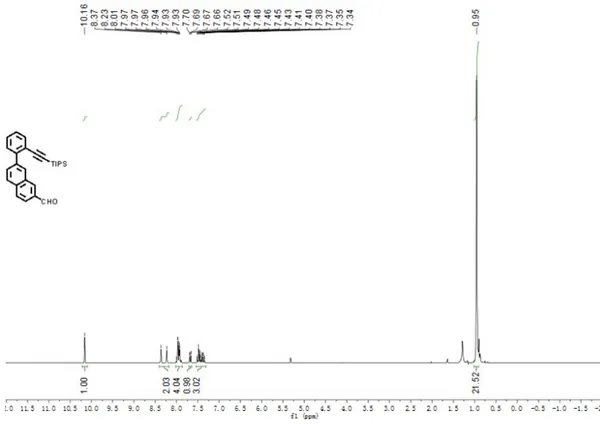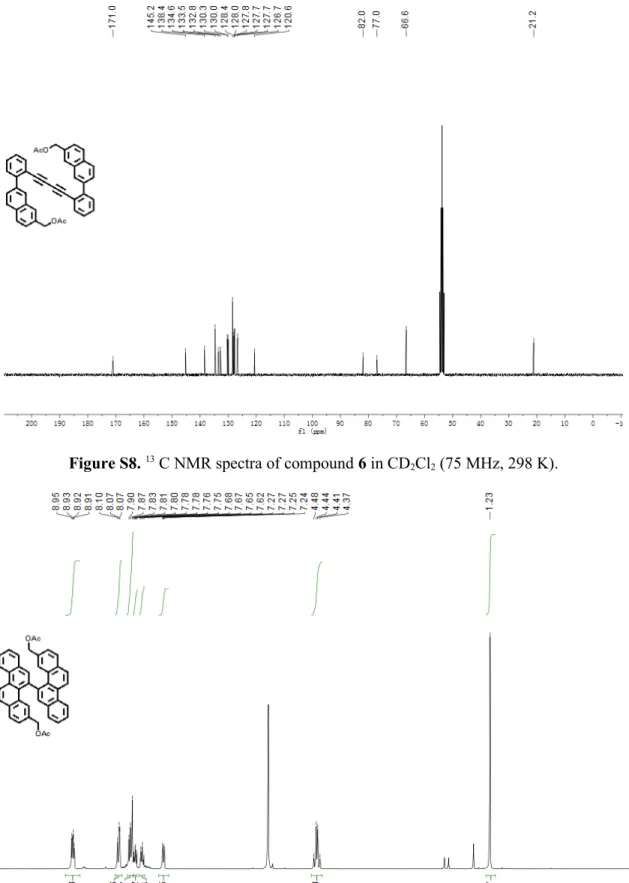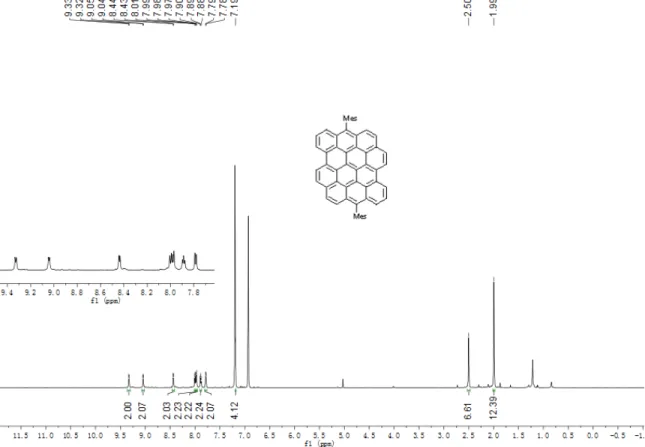Supplementary Information
for
Strong Exciton-Photon Coupling in a Nanographene Filled Microcavity
By
D M Coles1, Q Chen2, L C Flatten3, J M Smith3, K Müllen2, A Narita2 and D G Lidzey1
1) Department of Physics & Astronomy, University of Sheffield, Sheffield S3 7RH, UK
2) Max Planck Institute for Polymer Research, Mainz D-55128, Germany
3) Department of Materials, University of Oxford, Oxford OX1 3PH, UK
Synthesis Methods
General methods
All reactions working with air- or moisture- sensitive compounds were carried out under argon atmosphere using standard Schlenk line techniques. Unless otherwise noted, all starting materials, solvents, and reagents were purchased from commercial sources and used without further purification. Thin layer chromatography (TLC) was done on silica gel coated aluminum sheets with F254 indicator and column chromatography separation was performed with silica gel (particle size 0.063-0.200 mm). Melting points were determined on a Büchi hot stage apparatus and were uncorrected. Nuclear Magnetic Resonance (NMR) spectra were recorded using Bruker DPX 250, Bruker DPX 300, and Bruker DPX 700 MHz NMR spectrometers. Chemical shifts (δ) were expressed in ppm relative to the residual of solvent. Coupling constants (J) were recorded in Hertz. Field desorption mass (FD-MS) spectra were measured using a VG instruments ZAB 2-SE-FPD using 8 kV accelerating voltage. High resolution mass spectra (HRMS) were recorded on a Bruker Reflex II-TOF spectrometer by matrix-assisted laser decomposition/ionization (MALDI) using 7,7,8,8-tetracyanoquinodimethane (TCNQ) as matrix.
Synthetic details
DBOV-Mes was synthesized as shown in Scheme S1, adapting and partially improving a procedure we have recently reporte.1,2 Starting materials 11 and 22 were prepared
Scheme S1. Synthetic route towards DBOV-Mes.
7-(2-((Triisopropylsilyl)ethynyl)phenyl)-2-naphthaldehyde (3)
:
To a 250-mL Schlenk flask were added (2-((triisopropylsilyl)ethynyl)phenyl)boronic acid 1 (2.12 g, 7.02 mmol), 7-bromo-2-naphthaldehyde 2 (1.20 g, 6.38 mmol), and Na2CO3
(2.23 g, 21.1 mmol). The flask was evacuated and backfilled with Ar for 3 times. Then toluene/EtOH/H2O = 4:1:1 (72 mL/18 mL/18 mL) was added via a syringe. After
degassed by bubbling with Ar for 15 min, Pd(PPh3)4 (369 mg, 0.319 mmol) was added in
extracted with ethyl acetate (50 mL) for 3 times. The combined organic layers were washed with brine (80 mL), dried over Na2SO4, and evaporated. The residue was purified
by silica gel column chromatography (n-hexane/ethyl acetate = 10 : 1) to give the title compound (2.80 g, 97% yield) as colorless oil. TLC Rf = 0.5 (n-hexane/ethyl acetate = 10
: 1); 1H NMR (250 MHz, CD
2Cl2) δ 10.16 (s, 1H), 8.30 (d, J = 33.5 Hz, 2H), 8.04 – 7.82
(m, 4H), 7.73 – 7.59 (m, 2H), 7.54 – 7.20 (m, 3H), 1.03 – 0.90 (m, 21H); 13C NMR (75
MHz, CDCl3) δ 192.4, 143.5, 139.7, 135.8, 135.1, 134.4, 134.0, 132.6, 131.2, 129.9,
129.6, 128.9, 128.8, 127.7, 127.6, 122.9, 122.4, 106.2, 94.8, 18.6, 11.3. FD-MS (8 kV):
m/z 412.9; HRMS (MALDI-TOF): m/z Calcd for C28H30OSi: 413.2295 [M+H]+, found:
413.2302.
7-(2-Ethynylphenyl)-2-naphthaldehyde
(4)
:
To a solution of 7-(2-((triisopropylsilyl)ethynyl)phenyl)-2-naphthaldehyde (3) (2.80 g, 6.78 mmol) in anhydrous tetrahydrofuran (THF) (50 mL) was added tetra-n -butylammonium fluoride (TBAF) (6.78 mmol, 6.78 mL, 1.00 M in THF) dropwise, and the mixture was stirred at room temperature for 2 h. After completion of the reaction, MeOH (10 mL) was added followed by stirring for another 30 min. Then the mixture was diluted with ethyl acetate (100 mL), washed with water (50 mL) and brine (50 mL), dried over Na2SO4, and evaporated. The residue was purified by silica gel column
130.1, 129.7, 129.2, 128.0, 128.0, 123.4, 83.2, 80.9; FD-MS (8 kV): m/z 256.6; HRMS (MALDI-TOF): m/z Calcd for C19H12O: 256.0888 [M]+, found: 256.0868.
1,4-Bis(2-(7-formylnaphthalen-2-yl)phenyl)buta-1,3-diyne (5)
:
To a solution of 7-(2-ethynylphenyl)-2-naphthaldehyde (4) (1.60 g, 6.24 mmol) in dry
N,N-dimethylformamide (16 mL) was added CuCl (620 mg, 6.24 mmol). The mixture was heated at 80 °C under air for 12 h. After completion of the reaction, the mixture was cooled down to room temperature, and then diluted with ethyl acetate (100 mL) and washed with 1 N HCl (50 mL). The aqueous phase was extracted with ethyl acetate (30 mL) for 3 times. The combined organic layers were washed with saturated solution of Na2CO3 (60 mL), brine (60 mL), dried over Na2SO4, and concentrated in vacuo. The
precipitated solid was collected by filtration and washed with cold methanol (30 mL) to give compound 5 (1.34 g, 98%) as a white solid. TLC Rf = 0.2 (n-hexane/ethyl acetate =
4 : 1); Mp: 206.1 – 206.9 °C; 1H NMR (300 MHz, CD
2Cl2) δ 10.10 (s, 1H), 8.32 (s, 1H),
8.13 (s, 1H), 7.98 – 7.90 (m, 2H), 7.88 – 7.81 (m, 2H), 7.68 – 7.57 (m, 1H), 7.53 – 7.45 (m, 1H), 7.42 – 7.30 (m, 1H); 13C NMR (75 MHz, CD
2Cl2) δ 192.3, 144.5, 139.2, 136.0,
135.0, 134.9, 134.7, 132.9, 130.8, 130.3, 130.1, 129.9, 129.2, 128.1, 128.0, 123.4, 120.5, 81.9, 77.1; FD-MS (8 kV): m/z 510.6; HRMS (MALDI-TOF): m/z Calcd for C38H22O2:
1,4-Bis(2-(7-diacetoxymethylnaphthalen-2-yl)phenyl)buta-1,3-diyne (6)
:
To a solution of 1,4-bis(2-(7-formylnaphthalen-2-yl)phenyl)buta-1,3-diyne (5) (900 mg, 1.76 mmol) in a mixture of THF (150 mL) and methanol (30 mL) was added NaBH4 (200
mg, 5.29 mmol). The mixture was stirred at room temperature for 1 h. After completion of the reaction, acetone (10 mL) was added into the mixture and stirred for 10 min. The solvents were evaporated and the residue was redissolved in ethyl acetate (50 mL), and washed with water (50 mL), brine (50 mL), and dried over Na2SO4. The solvent was tehn
removed in vacuo to obtain a diol intermediate (892 mg, 99% yield) as a white solid. The diol intermediate (892 mg, 1.73 mmol) was redissolved in anhydrous dichloromethane (150 mL), and then triethylamine (534 mg, 5.28 mmol), 4-dimethylaminopyridine (65 mg, 0.53 mmol), and acetic anhydride (539 mg, 5.28 mmol) were added. The mixture was stirred at room temperature for 2 h. After completion of the reaction, the solvent was evaporated and the residue was purified by column chromatography over silica gel (n -hexane/ethyl acetate = 10 : 1) to give compound 6 (912 mg, 87% yield) as a white solid. TLC Rf = 0.3 (n-hexane/ethyl acetate = 10 : 1); Mp: 60.0 – 60.5 °C; 1H NMR (300 MHz,
CD2Cl2) δ 8.02 (d, J = 1.7 Hz, 2H), 7.94 – 7.86 (m, 4H), 7.82 (d, J = 8.5 Hz, 2H), 7.74
(dd, J = 8.5, 1.8 Hz, 2H), 7.69 – 7.61 (m, 2H), 7.58 – 7.45 (m, 6H), 7.38 (ddd, J = 7.7, 6.6, 2.2 Hz, 2H), 5.29 (s, 4H), 2.13 (s, 6H). 13C NMR (75 MHz, CD
2Cl2) δ 171.0, 145.1,
138.4, 134.6, 134.6, 133.4, 132.7, 130.2, 130.0, 128.4, 128.0, 127.8, 127.7, 127.6, 126.6, 120.5, 81.9, 76.9, 66.6, 21.2; FD-MS (8 kV): m/z 597.0; HRMS (MALDI-TOF): m/z
3,3'-Diacetoxymethyl-5,5'-bichrysene (7)
:
1,4-Bis(2-(7-diacetoxymethylnaphthalen-2-yl)phenyl)buta-1,3-diyne (6) (800 mg, 1.34 mmol) and PtCl2 (89.0 mg, 0.334 mmol) in a 250-mL Schlenk flask was dried under
vacuum for 1 h, and then the apparatus was evacuated and backfilled with Ar for 3 times before anhydrous toluene (80 mL) was added. The mixture was degassed by three freeze-pump-thaw cycles and then heated at 90 °C for 60 h. The reaction was monitored by 1H
NMR. After completion of the reaction, the mixture was cooled down to room temperature and the solvent was evaporated. The resulting yellow brown residue was purified by column chromatography over silica gel (n-hexane/ethyl acetate = 10 : 1) to give the title compound (260 mg, 33% yield) as a white solid. TLC Rf = 0.3
(n-hexane/ethyl acetate = 4 : 1); Mp: 196.2 – 196.9 °C; 1H NMR (300 MHz, CD 2Cl2) δ
9.00 – 8.87 (m, 4H), 8.14 – 8.04 (m, 4H), 7.93 – 7.82 (m, 6H), 7.81 – 7.72 (m, 2H), 7.70 – 7.60 (m, 2H), 7.30 – 7.22 (m,, 2H), 4.51 – 4.34 (m, 4H), 1.23 (s, 6H). 13C NMR (75
MHz, CD2Cl2) δ 170.4, 130.7, 128.7, 128.4, 127.4, 127.4, 126.8, 125.6, 123.7, 122.3,
66.0, 20.0; FD-MS (8 kV): m/z 598.3; HRMS (MALDI-TOF): m/z Calcd for C42H30O4:
5,14-Diacetoxymethylbenzo[
a
]dinaphtho[2,1, 8-
cde
:1',2',3',4'-ghi]perylene (8)
:
A solution of 3,3'-diacetoxymethyl-5,5'-bichrysene (7) (60 mg, 0.10 mmol) in dichloromethane (60 mL) was cooled down to –78 °C, and then trifluoromethanesulfonic acid (TFMSA) (0.6 mL) was added slowly via a syringe. The mixture was stirred for about 10 min to make the solution homogeneous, and then a solution of 2,3-dichloro-5,6-dicyano-1,4-benzoquinone (DDQ) (50 mg, 0.22 mmol) in anhydrous dichloromethane (6 mL) was added dropwise. The mixture was stirred at this temperature for another 2 h. After completion of the reaction, the mixture was poured into cold saturated aqueous solution of Na2CO3 (10 mL), and then extracted with dichloromethane (30 m) for 2 times.
The combined organic layers were washed with brine (50 mL), dried over Na2SO4, and
evaporated. The residue was purified by column chromatography over silica gel (n -hexane/ethyl acetate = 4 : 1) to give title compound (15 mg, 25% yield) as a yellow solid. TLC Rf = 0.3 (n-hexane/ethyl acetate = 3 : 1); Mp: 281.1 – 282.7 °C; 1H NMR (250
MHz, CD2Cl2) δ 9.12 – 9.01 (m, 4H), 8.46 – 8.31 (m, 4H), 8.30 – 8.21 (m, 2H), 8.17 –
8.08 (m, 2H), 7.87 – 7.65 (m, 4H), 5.57 – 5.46 (m, 2H), 4.90 – 4.80 (m, J = 12.8, 1.8 Hz, 2H), 1.84 – 1.70 (m, 6H); 13C NMR (63 MHz, CD
2Cl2) δ 170.7, 133.0, 131.2, 130.0,
5,14-Diformylbenzo[
a
]dinaphtho[2,1, 8-
cde
:1',2',3',4'-
ghi
]perylene (9)
:
To a solution of 5,14-diacetoxymethylbenzo[a]dinaphtho[2,1,8-cde
:1',2',3',4'-ghi]perylene (8) (60 mg, 0.10 mmol) in a mixture of dichloromethane (30 mL) and methanol (10 mL) was added K2CO3 (1.2 g, 8.7 mmol). The suspension was stirred at
room temperature for 24 h. After completion of the reaction, the insoluble solid was filtered off and the filtrate was washed with water (20 mL), brine (20 mL), dried over Na2SO4, and evaporated. The residue was dried under vacuum using oil pump for 2 h.
The obtained residue was redissolved in dry dichloromethane (40 mL), and then pyridinium chlorochromate (PCC) (80 mg, 0.37 mmol) was added in portions under vigorous stirring. The mixture was stirred for 2 h at room temperature, and methanol (1 mL) was added after confirming the completion of the reaction. The insoluble solid was filtered off and the filtrate was concentrated in vacuo. The residue was purified by column chromatography over silica gel (n-hexane/ethyl acetate = 4 : 1) to give title compound (30 mg, 59% yield in two steps) as red solid. TLC Rf = 0.3 (n-hexane/EA = 4 :
1); Mp: >400 °C; 1H NMR (300 MHz, C
2D2Cl4) δ 9.46 (s, 2H), 9.01 (d, J = 9.1 Hz, 2H),
8.90 (d, J = 8.4 Hz, 2H), 8.52 – 8.42 (m, 4H), 8.34 (t, J = 9.1 Hz, 4H), 7.83 – 7.72 (m, 2H), 7.64 (dd, J = 8.1, 1.1 Hz, 2H); 13C NMR (75 MHz, C
2D2Cl4) δ 190.8, 133.7, 131.7,
6,14-Dimesityldibenzo[
hi
,
st
]ovalene (DBOV-Mes)
:
To a solution of 5,14-diformylbenzo[a]dinaphtho[2,1,8-cde:1',2',3',4'-ghi]perylene (9) (5 mg, 10 µmol) in anhydrous THF (5 mL) was added mesitylmagnesium bromide (0.15 mL, 150 µmol, 1.0 M in ether) dropwise under the protection of Ar. The mixture was stirred at room temperature for 2 h. After completion of the reaction, the yellow green colored solution was poured into saturated aqueous solution of NH4Cl (10 mL) and then
extracted with ethyl acetate (20 mL) for 3 times. The combined organic layers were washed with brine (30 mL), dried over Na2SO4, and evaporated. After drying under
vacuum using an oil pump for 2 h, the residue was redissolved in anhydrous dichloromethane (50 mL) and BF3·OEt2 (0.5 mL) was added using a syringe. The mixture
was stirred at room temperature for 2 h. After completion of the reaction, the mixture was poured into saturated NaHCO3 solution (10 mL). The organic phase was separated and
dried over Na2SO4. The solvents were evaporated under reduced pressure and the residue
was purified by column chromatography over silica gel (eluent: n-hexane/DCM = 10 : 1) to give DBOV-Mes (4 mg, 56%) as blue powder. TLC Rf = 0.6 (n-hexane/ethyl acetate =
10 : 1); Mp: >400 °C; 1H NMR (700 MHz, o-dichlorobenzene-d
6) δ 9.33 (d, J = 7.8 Hz,
2H), 9.04 (d, J = 7.2 Hz, 2H), 8.44 (d, J = 7.4 Hz, 2H), 8.00 (d, J = 9.1 Hz, 2H), 7.98 (d,
NMR and MS Spectra
Figure S1.1H NMR spectra of compound 3 in CD
2Cl2 (250 MHz, 298 K).
Figure S2.13C NMR spectra of compound 3 in CD
Figure S3.1H NMR spectra of compound 4 in CD
2Cl2 (300 MHz, 298 K).
Figure S4.13 C NMR spectra of compound 3 in CD
Figure S5.1H NMR spectra of compound 5 in CD
Figure S7.1H NMR spectra of compound 6 in CD
2Cl2 (300 MHz, 298 K).
Figure S8.13 C NMR spectra of compound 6 in CD
Figure S9.1H NMR spectra of compound 7 in CD
2Cl2 (300 MHz, 298 K).
Figure S10.13 C NMR spectra of compound 7 in CD
Figure S11.1H NMR spectra of compound 8 in CD
2Cl2 (250 MHz, 298 K).
Figure S12.13 C NMR spectra of compound 8 in CD
Figure S13.1H NMR spectra of compound 9 in C
2D2Cl4 (300 MHz, 298 K).
Figure S14.13 C NMR spectra of compound 9 in C
Figure S15.1H NMR spectra of DBOV-Mes in o-dichlorobenzene (d
Figure S17. NOESY spectra of DBOV-Mes in o-dichlorobenzene (d6) (700 MHz, 343 K).
Figure S18. HR MALDI-TOF MS spectra of DBOV-Mes.
Absorption and photoluminescence in solution
Figure S19. Absorption and photoluminescence of DBOV-Mes in toluene (10-5 mol/L). The
excitation wavelength is 355 nm.
Photostability
Photostability of the DBOV-Mes was compared to two other organic materials that are used to reach the strong coupling regime – the J-aggregate
5,6-dichloro-2[3-[5,6- dichloro-1-ethyl-3-(3-sulfopropyl)-2(3H)-benzimidazolidene]-1-propenyl]-1-ethyl-3-(3-sulfopropyl) benzimidazolium hydroxide (TDBC)3-5 and the small molecule
bromine-substituted boron-dipyrromethene (BODIPY-Br).6,7 Films of DBOV-Mes in polymethyl
methacrylate, TDBC in polyvinyl alcohol and BODIPY-Br in polystyrene were prepared. A white light supercontinuum laser was used to probe the absorption of the films as function of time. The laser was focused to a spot diameter of 2 μm at a spectrally integrated total power density of 1.3×106 Wcm-2. The optical density of the films was
adjusted through chromophore concentration such that Ap=
∫
450nm680nm
α(λ)I'(λ)d λ was
I'
(λ)=where Iual across the samples . was focused¿a spot diamter2tion of the films . inated with a¿−l I(λ)
∫
0nm∞
I(λ)d λ
and I(λ) is the laser excitation spectrum. This ensured that each film absorbed the same optical power. The absorbance of each of the films at t = 0 is shown in Figure S20, along with I'(λ).
Figure S20. Absorbance of thin films containing the different chromophores. The absorbance and thickness of the films are typical of those used in a strong-coupled microcavity. The dashed grey line is the normalized excitation spectrum of the laser used in the photobleaching measurements.
photo-Figure S21. Spectrally integrated absorbed laser power as a function of time.
Figure S22. Time resolved absorbance of (a) DBOV-Mes, (b) TDBC and (c) BODIPY-Br doped thin films.
References
1. T. Dumslaff, B. Yang, A. Maghsoumi, G. Velpula, K. S. Mali, C. Castiglioni, S. D. Feyter, M. Tommasini, A. Narita, X. Feng, and K. Müllen, J. Am. Chem. Soc.2016 138 (14), 4726-4729.
2. G. M. Paterno, Q. Chen, X.-Y. Wang, J. Liu, S. G. Motti, A. Petrozza, X. Feng, G. Lanzani, K. Müllen, A. Narita, and F. Scotognella, Angew. Chem. Int. Ed., 2017, DOI: 10.1002/anie.201700730
3. J. R. Tischler, M. S. Bradley, V. Bulović, J. H. Song and A. Nurmikko, Phys. Rev. Lett.2005, 95, 036401.
4. J. George, S. Wang, T. Chervy, A. Canaguier-Durand, G. Schaeffer, J. M. Lehn, J. A. Hutchison, C. Genet, T.W. Ebbesen, Faraday Discuss.2015, 178, 281–294.
5. D. M. Coles, P. Michetti, C. Clark, W. C. Tsoi, A. M. Adawi, J. S. Kim, D. G. Lidzey,
Advanced Functional Materials2011, 21, 3691–3696.
6. R. T. Grant, P. Michetti, A. J. Musser, P. Gregoire, T. Virgili, E. Vella, M. Cavazzini, K. Georgiou, F. Galeotti, C. Clark, J. Clark, C. Silva, D. G. Lidzey, Advanced Optical Materials2016, 4, 1615–1623.









